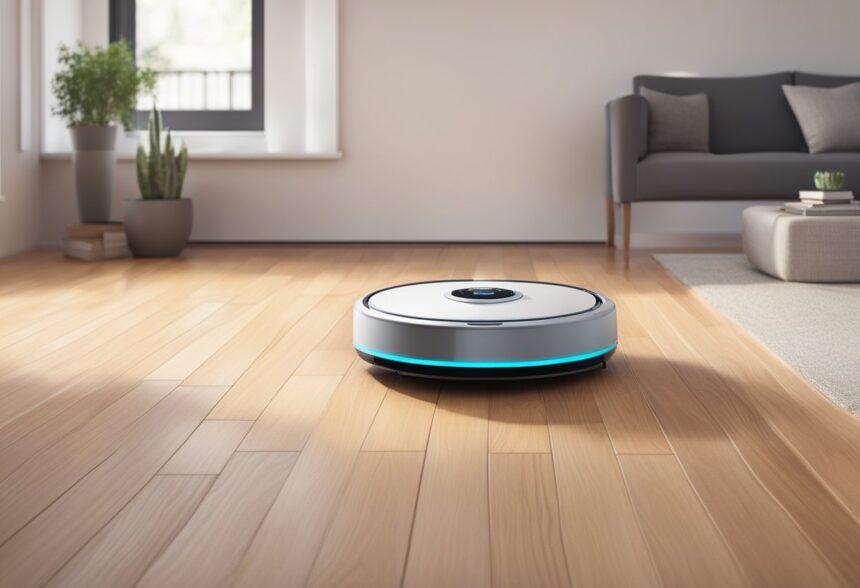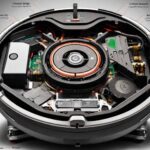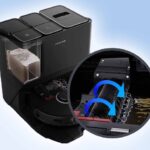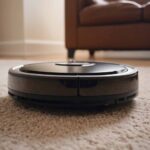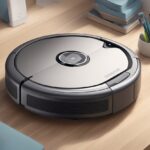The key to their success lies in their sophisticated sensors and multi-room mapping capabilities. Some high-end models seamlessly move across transitions and even remember the layout of each floor, resuming their job without missing a spot.
Whether it’s tackling a flight of stairs or detecting ledges, contemporary robot vacuums are designed for minimal human intervention. The integration of these features marks a significant leap forward in the realm of automated home cleaning, making it an indispensable tool for homeowners.
As homes grow in complexity, with varying designs and floor types, the need for adaptive cleaning tools has become apparent.
Robot vacuums rise to the occasion, where their advanced navigation systems, durable hardware, and intelligent software work in unison to keep multi-floor homes spotless.
They handle the daunting task of cleaning expansive spaces, where the convenience of setting and forgetting becomes the norm for maintaining a pristine environment. With continuous improvements in technology, robot vacuums are increasingly capable of providing a one-stop solution for the diverse challenges of multi-floor cleaning.
Understanding Robot Vacuums
Modern robot vacuums are sophisticated devices designed to clean homes autonomously with little oversight.
They utilize advanced technologies to navigate homes, detect obstacles, and provide options for both vacuuming and mopping, ensuring effective cleaning performance on various floor types.
AI and Navigation Technologies
Robot vacuums are equipped with AI (Artificial Intelligence) which allows them to learn and adapt to the home’s layout. Smart mapping capabilities are central to their operation; by using sensors and cameras, they can map a home’s floor plan and remember it for future cleaning tasks, which is especially useful for multi-floor homes.
Some robots employ TrueMapping technology, an enhanced mapping system that creates precise and efficient cleaning paths.
Obstacle Avoidance and Cliff Sensors
Avoiding obstacles and preventing falls is crucial for a robot vacuum. They come integrated with obstacle avoidance sensors to detect and navigate around objects like furniture and toys.
Cliff sensors are equally important, as they prevent the vacuum from tumbling downstairs. These safety features help the vacuum move seamlessly between different areas, maintaining uninterrupted operation.
Comparing Vacuuming and Mopping Functions
Robot vacuums often feature both vacuuming and mopping functions, allowing them to tackle various types of debris and dirt. While the vacuuming function is designed to pick up dust and small particles, the mopping feature aims to clean harder, stuck-on messes on floors.
However, their effectiveness can vary, and it’s important to compare specific models to determine their suitability for different cleaning tasks.
Evaluating Flooring Compatibility
Choosing the right robot vacuum for a home involves understanding how different models adapt to various floor types. This is crucial for homes with a mix of hard floors and carpets, ensuring the robot transitions smoothly and cleans effectively on all surfaces.
Hard Floors and Carpets
Hard floors, such as tiles or hardwood floors, require a robot vacuum that can pull debris out of crevices and navigate without scratching hardwood surfaces.
These vacuums should have soft brushes to sweep debris without causing damage. On carpets and rugs, vacuums need a different kind of brush roll to agitate fibers and lift dirt. A quality robot vacuum for multiple floors will automatically detect the floor type and adjust its brush roll accordingly.
For instance, when a robot vacuum transitions from a hard floor to a carpeted area, it should ideally increase its suction power to ensure thorough cleaning of the carpet’s deeper fibers.
Conversely, on hard flooring, it may reduce its suction to prevent scattering debris and to operate more efficiently.
Adjusting Suction Power and Mop Settings
It is important for a robot vacuum to modulate its suction power depending on the floor type. Effective debris pickup on soft flooring, like carpets, often needs higher suction, whereas hard floors may require less. The best robot vacuums can automatically recognize the change in floor type and adjust suction strength for optimal performance.
Certain advanced models are also equipped with mopping capabilities, which they should only activate on suitable hard floor surfaces. Therefore, the robot must possess intelligent mop settings to prevent moisture damage to carpets or rugs.
These settings control the amount of water used and the pressure applied by the mopping mechanism to clean tiles without leaving streaks or pooling water.
Multi-Floor Mapping and Navigation

Robot vacuums have evolved to handle complex home layouts with ease, particularly through innovations in multi-floor mapping and advanced navigation.
These systems enable vacuums to transition across different floor levels, remembering layouts and barriers to optimize the cleaning process.
Creating and Storing Multiple Maps
Modern robot vacuums navigate using sophisticated algorithms that allow them to create and store detailed maps of each floor in a multi-level home.
With sensors and cameras, these smart devices can scan and remember distinct floor plans, making it possible for a single robot to clean several floors without getting “lost.”
The ability to store multiple maps is crucial for households that want a vacuum that can seamlessly switch between various levels, ensuring thorough coverage and cleaning efficiency.
The only caveat is that you need to physically move your Robot vacuum to each floor. Although robot vacuums can climb some pretty big ramps, there is no commercially available one that can climb stairs.
Virtual Boundaries and No-Go Zones
Setting up virtual boundaries and no-go zones is a critical feature in multi-floor homes. Robot vacuums equipped with this feature prevent disruption and potential damage by avoiding areas that are off-limits, like pet areas or rooms with delicate items.
Homeowners can establish these invisible barriers through the vacuum’s companion app, directing the device to steer clear of specific zones.
This smart navigation respects the preset home layout parameters, tailoring cleaning sessions to the unique contours and requirements of each living space.
Integration with Smart Home Ecosystems

Modern robot vacuums integrate seamlessly with smart home ecosystems, allowing for efficient and centralized control.
They complement a sophisticated network of smart devices through advanced features like voice command compatibility and remote operability via smartphone apps.
Voice Commands and Assistant Compatibility
Robot vacuums have evolved to understand and respond to voice commands through Alexa or Google Assistant. Users can initiate cleaning, pause tasks, or send the vacuum to its charging dock using simple voice instructions.
For instance, iRobot Roomba s9+ can be easily directed with voice commands via any Alexa-enabled device or through Google Assistant, making it a hands-free experience.
Smartphone Apps and Remote Control
Through Wi-Fi connectivity, users can harness the power of smartphone apps to control their robot vacuums remotely.
The iRobot Home app pairs with models like the Roomba 694, offering scheduling and real-time updates on cleaning progress.
Similarly, the Roborock app grants access to various features, including custom cleaning modes and the creation of virtual no-go zones. Such apps embody the essence of convenience, providing control of the vacuum without needing to be physically present.
Choosing the Right Robot Vacuum for Your Home
When it comes to optimizing home cleaning, selecting the ideal robot vacuum involves balancing cost against features such as suction power, battery life, and the ability to handle different floor types and debris like pet hair.
Performance and Budget Considerations
When evaluating performance for a multi-floor home, powerful suction is a must-have feature to ensure thorough cleaning on various surfaces, from hardwood to thick carpets.
Battery life is equally critical, as a longer battery ensures the vacuum can handle larger spaces without needing a recharge mid-clean.
Homes with pets should prioritize vacuums designed to pick up pet hair effectively, which may also feature larger dustbins to accommodate more debris.
Budget-wise, it’s important to distinguish between necessary features and luxury add-ons. For a cost-effective choice, the Eufy RoboVac G30 is a budget pick that delivers on functionality without breaking the bank.
On the other hand, investing in a higher-end model like the iRobot Roomba j7+ provides advanced navigation and the convenience of setting schedules through a smartphone app.
Top Picks for Multi-Floor Homes
Several models stand out for multi-floor homes. The iRobot Roomba j7+ excels with its robust navigation system and ability to handle both hardwood floors and carpets.
It’s particularly adept at avoiding obstacles, making it a smart choice for homes with complex layouts.
The Roborock S7 features intelligent sonic mopping on top of its vacuuming capabilities, adapting its cleaning strategy to the floor type it encounters. It’s known for being quiet, making it a discreet and versatile cleaning aid.
For those looking for a comprehensive cleaning system, the Deebot T20 Omni offers a combination of vacuuming and mopping with an auto-empty station, significantly reducing the maintenance required by the homeowner.
Choosing a robot vacuum for a multi-floor home doesn’t have to be daunting.
By considering the size of your home, specific cleaning needs such as dealing with pet hair, and setting a flexible budget while prioritizing essential features over optional ones, finding the right fit becomes a straightforward process.
Maintenance and Upkeep
Regular maintenance and proper upkeep ensure that robot vacuums perform optimally, especially in homes with multiple floors.
Attention should be focused on the cleaning of dustbins and filters, as well as the care of the battery and its charging options.
Cleaning the Dustbin and Filters
The dustbin in a robot vacuum should be emptied after each use to maintain suction efficiency.
Filters, often HEPA-type, capture fine particles and allergens and should be cleaned or replaced according to the manufacturer’s instructions to keep the air in the home clean.
For instance, a high-performance model like the DEEBOT T9+ requires regular filter maintenance to continue to trap pollutants effectively.
Dustbin:
- Empty after each use.
- Check for and remove any trapped hair or debris.
Filters:
- HEPA: Clean every month, replace every 2-3 months.
- Washable filters: Rinse under running water, allow to air dry.
Battery Care and Charging Options
Ensuring battery longevity in robot vacuums involves careful charging practices. Robot vacuums generally return to their charging dock when battery life is low or after completing a cleaning cycle.
Batteries should not be overcharged; therefore, it’s beneficial if the vacuum has an intelligent charging system.
Battery Life:
- Use until low before returning to dock.
- Replace batteries every 1-2 years, depending on the model.
Charging:
- Always use the provided charging dock.
- If available, enable smart charging options to prevent overcharging.


